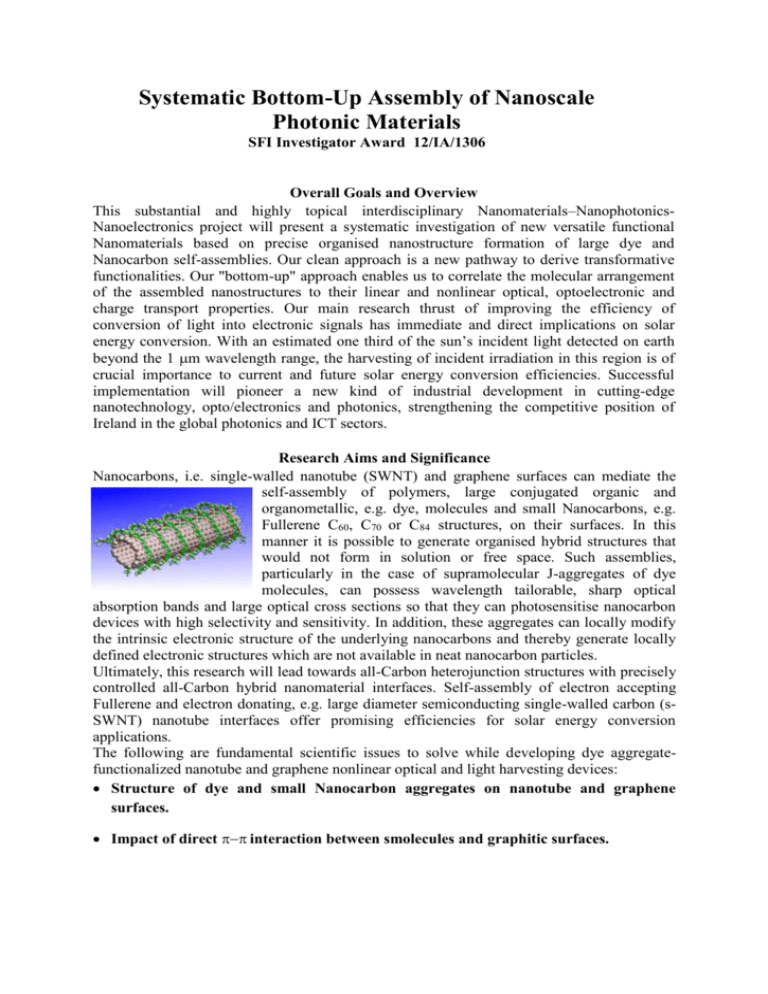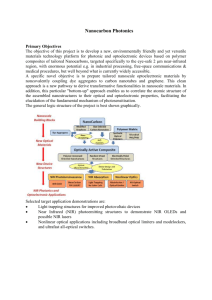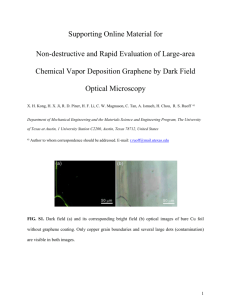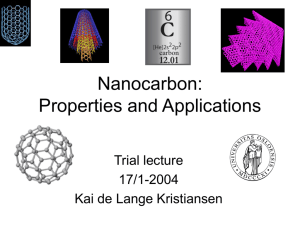sfi
advertisement

Systematic Bottom-Up Assembly of Nanoscale Photonic Materials SFI Investigator Award 12/IA/1306 Overall Goals and Overview This substantial and highly topical interdisciplinary Nanomaterials–NanophotonicsNanoelectronics project will present a systematic investigation of new versatile functional Nanomaterials based on precise organised nanostructure formation of large dye and Nanocarbon self-assemblies. Our clean approach is a new pathway to derive transformative functionalities. Our "bottom-up" approach enables us to correlate the molecular arrangement of the assembled nanostructures to their linear and nonlinear optical, optoelectronic and charge transport properties. Our main research thrust of improving the efficiency of conversion of light into electronic signals has immediate and direct implications on solar energy conversion. With an estimated one third of the sun’s incident light detected on earth beyond the 1 m wavelength range, the harvesting of incident irradiation in this region is of crucial importance to current and future solar energy conversion efficiencies. Successful implementation will pioneer a new kind of industrial development in cutting-edge nanotechnology, opto/electronics and photonics, strengthening the competitive position of Ireland in the global photonics and ICT sectors. Research Aims and Significance Nanocarbons, i.e. single-walled nanotube (SWNT) and graphene surfaces can mediate the self-assembly of polymers, large conjugated organic and organometallic, e.g. dye, molecules and small Nanocarbons, e.g. Fullerene C60, C70 or C84 structures, on their surfaces. In this manner it is possible to generate organised hybrid structures that would not form in solution or free space. Such assemblies, particularly in the case of supramolecular J-aggregates of dye molecules, can possess wavelength tailorable, sharp optical absorption bands and large optical cross sections so that they can photosensitise nanocarbon devices with high selectivity and sensitivity. In addition, these aggregates can locally modify the intrinsic electronic structure of the underlying nanocarbons and thereby generate locally defined electronic structures which are not available in neat nanocarbon particles. Ultimately, this research will lead towards all-Carbon heterojunction structures with precisely controlled all-Carbon hybrid nanomaterial interfaces. Self-assembly of electron accepting Fullerene and electron donating, e.g. large diameter semiconducting single-walled carbon (sSWNT) nanotube interfaces offer promising efficiencies for solar energy conversion applications. The following are fundamental scientific issues to solve while developing dye aggregatefunctionalized nanotube and graphene nonlinear optical and light harvesting devices: Structure of dye and small Nanocarbon aggregates on nanotube and graphene surfaces. Impact of direct interaction between smolecules and graphitic surfaces. Fundamental mechanism of photosensitisation of nanotubes and graphene sheets using tailored dye aggregates, as measured by ultrafast nonlinear optical and photoconduction responses. Fundamental mechanism of local modulation of nanotube and graphene electronic structure through aggregate electric fields and polymerised aggregate pressure. These results could have a broad impact on nanoscale carbon nanotube and graphene photonics, as their well-defined and enhanced optical properties will open up new applications in nonlinear optics, photodetection and opto/electronic transport. Particularly, improving the capture efficiency of light by aggregates and subsequent translation of the capture event into electronic signals is relevant for solar energy generation. Project Structure A schematic outline of the complete project concept and its potential industrial impact is shown below. Presently, little is known about basic physical processes governing such hybrid carbon nanomaterials with heterogeneous energy levels and exciton binding energies. Under the leadership of Prof Werner J Blau, an internationally well-known principal investigator, the project will explore and understand the self-assembly and charge transfer of these nanoscale heterostructures, predict and measure their structural and optical properties, and investigate the properties and technological feasibility of the resulting nano-diodes and nanophotovoltaic devices. The strongly anticipated success of the project is based on the demonstrated expertise of the PI, augmented by several established and highly productive collaborations with specialist colleagues who will be involved as official collaborators as follows: • Prof. Mathias Senge, TCD Chemistry – Synthesis of dye molecules with controlled morphology and aggregation properties • Prof. Georg Duesberg, TCD Chemistry – Synthesis of structurally extremely well defined Nanocarbon, especially graphenes • Prof. Valeria Nicolosi TCD Physics and Chemistry – High Resolution TEM Specialist • Dr. Mazhar Bari Solarprint Ltd. Dublin – Fabrication and Testing of Nanomaterials in Practical Dye Doped Solar Cell Devices








